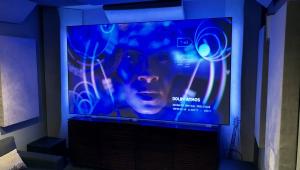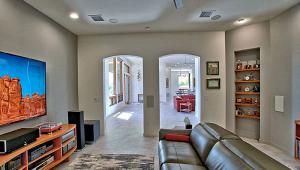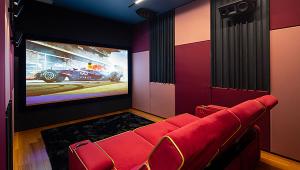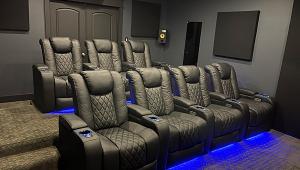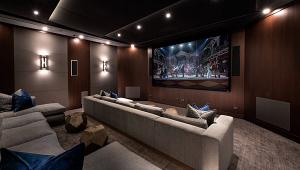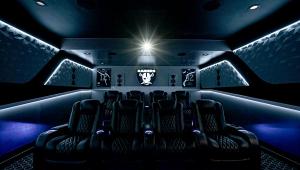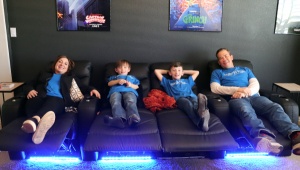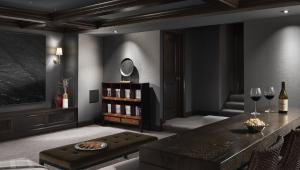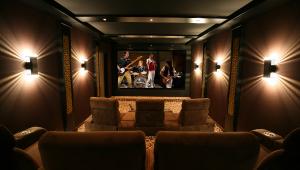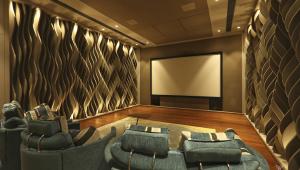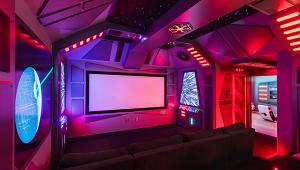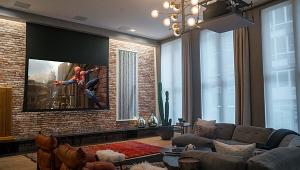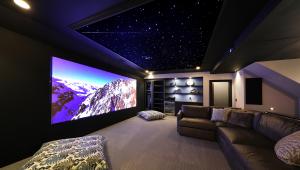I think every room should have a certain amount of absorption and diffusion based on its size in order to get good sound.
Unlocking the Best Audio Performance from Your System
 Recently I sat down with Anthony Grimani, President of PMI, Ltd., an acoustics consulting firm, to discuss room acoustics and home theater design.
Recently I sat down with Anthony Grimani, President of PMI, Ltd., an acoustics consulting firm, to discuss room acoustics and home theater design.
GA: Anthony, please start by explaining the services offered by your company, PMI, Ltd.
AG: PMI is a service company staffed with an engineering group primarily involved in designing home theater screening rooms, studios, and listening rooms. Our design group is mostly sound engineers and musicians, and our main thrust is to predict and document how a room is going to sound before it’s built. Our combined knowledge and experience of home theaters and recording studios is over 50 years. We use that knowledge and combine it with research data from the scientific community in all our designs.
A lot of people have opinions, but I don’t want to just opine. I want to make use of science and solid design principles. Our product is ultimately a color plan set that the builder, installer, wiring tech, and other various trades involved are going to use to build the space. It takes about 50 to 60 pages to describe everything from the framing to how you suspend the floors and ceilings, how to install the plumbing, HVAC, wiring, everything.
Our plans are chronological. In other words, the first few pages are about the framing, followed by plumbing and ventilation, then wall construction, acoustic treatments, and so on. We try to make it as easy as possible because listening rooms and theaters typically involve oddball construction methods.
We do both new construction and retrofit design. However, we are about more than room acoustics. We also design the video and optical portions of a media space. For instance, how big should the picture be, what color should the walls be, what kind of light control is required, etc., so that the final experience is the best it can be.

GA: How do you ensure that the plans are properly implemented? Do you supervise the construction?
AG: We conduct site visits throughout the construction to make sure there are no variances from the design and to assist with any questions that the construction group may have. We want to make sure that when the room is finished, it’s going to sound great and look great.
GA: What are the typical costs for your services?
AG: The costs are highly scalable, depending on what the customer is going to need, and they can range from $1,000 to over $45,000. The majority of our projects are in the $15,000-to-$25,000 range, but a customer could hire us for as little as $1,000 to do a basic layout of a room and get our advice about where to put speakers and room treatments to get the best performance based on their current situation. For $25,000, they’ll get a detailed plan set showing how to build the room, and for $45,000, they’ll get a complete plan set, calibration services, more site visits, and consultations, so it’s scalable.
GA: How much would you suggest a customer budget for design services, either for new construction or retrofit design of a media room
AG: We believe that 8 to 10 percent of the total budget should be devoted to architecture and design. Assume you’re going to spend about 10 percent of the budget engineering the room. If you’ve got a total budget of $250,000 including construction and A/V equipment, expect to spend about $25,000 on design. Our fees are not based on a percentage, but that’s what we recommend.
Also, consider that acoustic treatments should be another 10 percent of the budget. If you’ve spent $50,000 on speakers, processors, amps, projectors, switchers, etc., and you spend $5,000 for a CinePanel package of acoustic treatments for the room, you’re going to end up with really good sound.
But, you have to start with acoustic design, not finish. Too many people look at acoustics as the last consideration, not the first. Acoustic engineering and treatments are not an add-on accessory; they’re part of the entire system.
I use a short story about the Tower of Pisa to make my point. When it was designed and built, it was supposed to showcase the might of the Republic of Pisa. The founders wanted to show how powerful they had become by building this tower that was taller than anything else around. So, they hired an architect and a builder but didn’t hire an engineer to design the foundation and analyze the soil in the area. So they started construction, and soon the tower began to lean and became an embarrassment to the town of Pisa. In the ensuing 30 years, they had to work on reinforcing the tower so it wouldn’t collapse.
The moral of the story is, you don’t want to build a home theater and end up with an embarrassment, and you want to get the full value of your investment. Our job at PMI is to ensure that the foundation of the design is correct.
GA: What are some of the tests a consumer can do to identify acoustic problems, and how do they know if they need your services? Also, what are some simple things consumers can do to solve common room acoustic problems?
AG: One of the most common problems is bass irregularity, such as bass resonance. How do you identify those? One of the simple ways is to purchase a test DVD, such as the Avia disc, the 5.1 Audio Tool Kit, or the Video Essentials disc, which has audio test tones. Listen to the bass test tones and decide if all the bass frequencies sound about the same. If certain tones sound significantly louder, you have bass-resonance problems at those frequencies. You can do more detailed analysis by using a decibel meter, about $40 at RadioShack.
Once you objectively measure the problem frequencies, speaker and subwoofer placement is recommended first, followed by acoustic treatments, such as the MSR CineTrap Bass Absorbers.

Another problem is sound-reflection energy from reflective surfaces in the room. You can measure them very accurately with scientific tools, or more simply by clapping your hands. Try to figure out how long it takes the sound of your hands clapping to die out, or dissipate. You should hear it die out in less than 0.5 seconds. If there are echoes in the room created by parallel walls and untreated surfaces, you need to install absorptive materials, such as those found in the CinePanel acoustic-treatment kits.
CinePanel is a package of materials designed to absorb and diffuse sound in a home theater. Based on the size of the room, we figure out how much absorptive material is needed to achieve the ideal decay rate of reflective sound, which is about 0.3 seconds. The panels are a special design; they’re not foam, and they’re not fiberglass, which is typically used in acoustic panels. We found that using mineral wool sandwiched with fiberglass sheets, a material like the hull of a boat, actually gives you more absorption over a broader range of frequencies. CinePanel absorbers are actually a frictional and diaphragm absorber combined into one.

GA: In your literature, you mention another company, MSR, Inc. What is the relationship between PMI and MSR?
AG: PMI is a service company that doesn’t make or sell any products. MSR is a separate company I helped start that manufactures and sells acoustic-related products, such as the CineTrap bass absorbers, CinePanel acoustic diffusers and absorbers, Salon Acoustics products, and others. I helped start MSR because I was looking for acoustic-treatment products that simply didn’t exist. So, I decided to make them. Our business model is to recommend acoustic treatments based on room size and dimensions. Every room should have a certain amount of absorption and diffusion based on its size in order to get good sound.
- Log in or register to post comments

